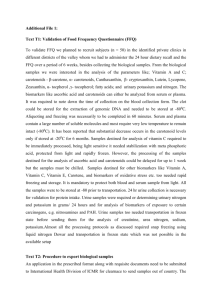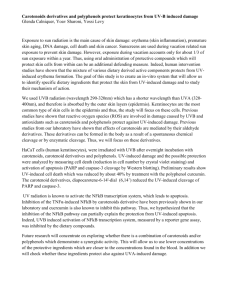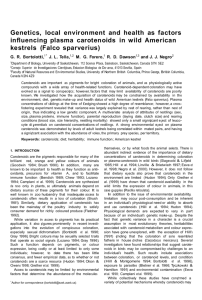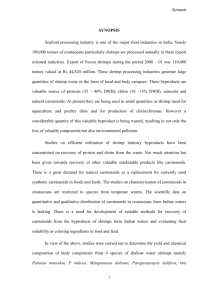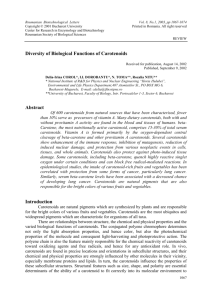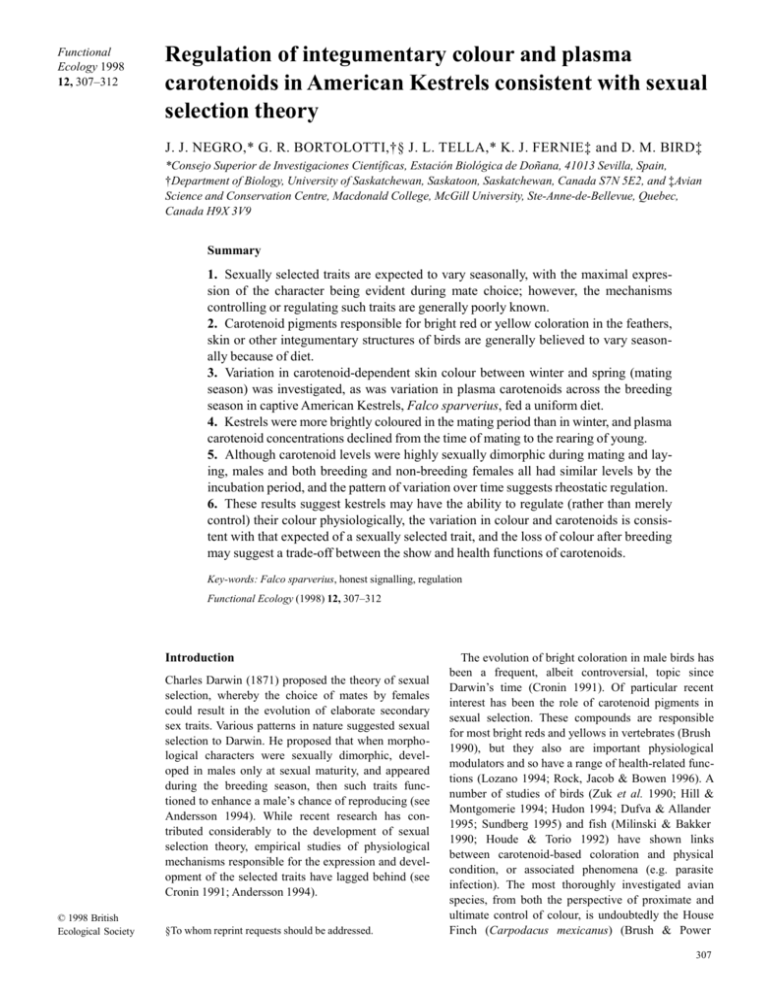
Functional
Ecology 1998
12, 307–312
Regulation of integumentary colour and plasma
carotenoids in American Kestrels consistent with sexual
selection theory
J. J. NEGRO,* G. R. BORTOLOTTI,†§ J. L. TELLA,* K. J. FERNIE‡ and D. M. BIRD‡
*Consejo Superior de Investigaciones Científicas, Estación Biológica de Doñana, 41013 Sevilla, Spain,
†Department of Biology, University of Saskatchewan, Saskatoon, Saskatchewan, Canada S7N 5E2, and ‡Avian
Science and Conservation Centre, Macdonald College, McGill University, Ste-Anne-de-Bellevue, Quebec,
Canada H9X 3V9
Summary
1. Sexually selected traits are expected to vary seasonally, with the maximal expression of the character being evident during mate choice; however, the mechanisms
controlling or regulating such traits are generally poorly known.
2. Carotenoid pigments responsible for bright red or yellow coloration in the feathers,
skin or other integumentary structures of birds are generally believed to vary seasonally because of diet.
3. Variation in carotenoid-dependent skin colour between winter and spring (mating
season) was investigated, as was variation in plasma carotenoids across the breeding
season in captive American Kestrels, Falco sparverius, fed a uniform diet.
4. Kestrels were more brightly coloured in the mating period than in winter, and plasma
carotenoid concentrations declined from the time of mating to the rearing of young.
5. Although carotenoid levels were highly sexually dimorphic during mating and laying, males and both breeding and non-breeding females all had similar levels by the
incubation period, and the pattern of variation over time suggests rheostatic regulation.
6. These results suggest kestrels may have the ability to regulate (rather than merely
control) their colour physiologically, the variation in colour and carotenoids is consistent with that expected of a sexually selected trait, and the loss of colour after breeding
may suggest a trade-off between the show and health functions of carotenoids.
Key-words: Falco sparverius, honest signalling, regulation
Functional Ecology (1998) 12, 307–312
Introduction
Charles Darwin (1871) proposed the theory of sexual
selection, whereby the choice of mates by females
could result in the evolution of elaborate secondary
sex traits. Various patterns in nature suggested sexual
selection to Darwin. He proposed that when morphological characters were sexually dimorphic, developed in males only at sexual maturity, and appeared
during the breeding season, then such traits functioned to enhance a male’s chance of reproducing (see
Andersson 1994). While recent research has contributed considerably to the development of sexual
selection theory, empirical studies of physiological
mechanisms responsible for the expression and development of the selected traits have lagged behind (see
Cronin 1991; Andersson 1994).
© 1998 British
Ecological Society
§To whom reprint requests should be addressed.
The evolution of bright coloration in male birds has
been a frequent, albeit controversial, topic since
Darwin’s time (Cronin 1991). Of particular recent
interest has been the role of carotenoid pigments in
sexual selection. These compounds are responsible
for most bright reds and yellows in vertebrates (Brush
1990), but they also are important physiological
modulators and so have a range of health-related functions (Lozano 1994; Rock, Jacob & Bowen 1996). A
number of studies of birds (Zuk et al. 1990; Hill &
Montgomerie 1994; Hudon 1994; Dufva & Allander
1995; Sundberg 1995) and fish (Milinski & Bakker
1990; Houde & Torio 1992) have shown links
between carotenoid-based coloration and physical
condition, or associated phenomena (e.g. parasite
infection). The most thoroughly investigated avian
species, from both the perspective of proximate and
ultimate control of colour, is undoubtedly the House
Finch (Carpodacus mexicanus) (Brush & Power
307
308
J. J. Negro et al.
1976; Hill 1990, 1991, 1992, 1995). The feather coats
of male finches have substantially more red than those
of females. The extent of red feathering appears to be
condition-dependent, and is used by females to identify a high-quality mate (Hill 1990, 1991). Coloration
in finches signals quality because carotenoids are
thought to be limited in the environment, and so only
birds that are superior foragers or are in good condition can be brightly coloured (Hill 1991; Hill &
Montgomerie 1994; see also Endler 1980).
Hill (1995) also proposed that the seasonal pattern
of plasma hues (and hence presumably carotenoid levels themselves) was consistent with the hypothesis
that plumage colour was sexually selected. The mechanism for such seasonal variation was again linked to
diet. There was indirect evidence that finches consumed more carotenoid-rich foods during the period
of moult than at other times of the year (Hill 1995).
The importance of dietary intake of carotenoids to
coloration at some level is unquestionable, because
these compounds cannot be synthesized de novo in
birds (Brush 1990; Hill 1996). However, it is equally
clear that ingestion of these pigments alone may not
be responsible for all variation in brightness (Hudon
1994), including two of three patterns that led Darwin
to his theory, i.e. age- and gender-dependent coloration (Bortolotti et al. 1996).
In this paper we explore the third of Darwin’s
observed patterns – seasonal variation. We provide
novel evidence for a programmed, physiological regulation of coloration and plasma carotenoids that is
consistent with the seasonal pattern expected of sexually selected traits. Instead of plumage, however, we
use the colour of the exposed integument, the cere,
lores and tarsi, of the American Kestrel (Falco
sparverius), a small falcon. The lores and ceres are
conspicuous structures that vary from a dull yellow to
a bright red-orange depending on the amount of
carotenoids (Bortolotti et al. 1996). Although most
researchers have focused their efforts on plumage,
there are several advantages to studying skin colour.
The colour of feathers is only indicative of conditions
at the time that they were grown. Furthermore, the
period of moult often does not coincide with when
mates are chosen, or when investigators capture their
subjects for evaluation. Factors such as the wear,
bleaching and structural properties of feathers can
make it difficult to assess plumage colour properly. In
contrast, the colour of skin or other ‘fleshy’ parts, such
as wattles or combs, may be a reflection of more
recent physiological events and hence have the potential to be an indicator of the current physical condition
of the individual (Burley, Price & Zann 1992; Lozano
1994; Owens & Short 1995; Bortolotti et al. 1996).
© 1998 British
Ecological Society,
Functional Ecology,
12, 307–312
Methods
This study was carried out in 1994 and 1995 at the
Avian Science and Conservation Centre of McGill
University, Canada. A colony of captive kestrels has
been maintained there since 1974 (Bird 1982), and at
the time of study consisted of about 400 individuals.
During autumn and winter (September–March),
kestrels were housed communally in unheated, indoor
pens of 25–35 individuals segregated by sex. In April,
some individuals were paired up by the investigators
in smaller breeding pens, while the remainder stayed
in the communal pens, still segregated by sex. The
breeding pens were cardboard boxes 1 m x 1 m x 2 m,
with solid walls but an open plastic mesh roof for
light, a nest box and rope perch. All birds were
exposed to natural photoperiod.
Of particular importance to this study of carotenoidbased coloration is that all kestrels had been maintained
exclusively on day-old cockerels (Gallus gallus domesticus) for at least 3 years prior to this investigation
(see also Bortolotti et al. 1996). Cockerels appear to be
a carotenoid-rich diet as poultry are given carotenoidsupplemented feed (Marusich & Bauernfeind 1981).
We have previously shown that variation in plasma
carotenoids during the mating period (April) was not
attributable to diet, parasites or androgen levels
(Bortolotti et al. 1996).
The within-individual variation in integumentary
colour was evaluated using a sample of 75 males and
49 females in late November 1994, April 1995 and
early December 1995. Entire pens of birds were sampled to avoid any potential bias of selecting individuals within a pen. During each sampling time, the
colours of the unfeathered ceres, lores and tarsi were
scored by G.R.B. by comparing the bird with a sixoption colour chart derived from paint samples
(Bortolotti et al. 1996). The extremes (6 = pale yellow,
1 = red-orange) were identified based on G.R.B.’s
extensive experience, and we considered birds to be
increasing in brightness as the amount of orange
increased (see also Bortolotti et al. 1996; Hill 1996).
Typically, brightly coloured birds were bright for all
three characters. A total colour score per individual
was derived by summing the scores of the three body
parts. These colour scores were previously demonstrated to correlate well with the concentration of
plasma carotenoids in April (Bortolotti et al. 1996).
Plasma carotenoid analyses were conducted four
times during the breeding season in 1995. A total of 121
male and 82 female kestrels was sampled in April,
which included those individuals scored for integumentary colour. The subsequent samples were taken in lateMay during egg-laying (after the third of four or five
eggs in a clutch), in mid-June during incubation, and in
mid-July during the nestling period for both members
of 28 breeding pairs. In mid-June we also sampled 11
non-breeding females from the communal pens.
For the quantification of carotenoids ≈ 0·45 ml of
blood was extracted from the jugular or brachial veins
using a heparinized syringe. The blood was centrifuged
to separate the plasma, which was frozen immediately
until subsequent analyses (about one month after
309
Regulation of
colour and
carotenoids in
kestrels
sampling). The methodology of Bortolotti et al. (1996)
was followed to quantify plasma carotenoids. Some
0·1 ml of plasma was diluted with acetone (1:10),
mixed well, and the flocculant protein was precipitated by centrifuging the sample at 1500 g for 10 min.
The supernatant was examined in a Beckman Du-70
spectrophotometer (Beckman Instruments Inc.,
Mississauga, Ontario, Canada) and the optical density
of the carotenoid peak at 476 nm was determined.
Carotenoid concentration was estimated as µ g ml–1 of
plasma, using a standard curve of lutein (alphacarotene-3,3´-diol, Sigma-Alorich Canada Ltd,
Oakville, Ontario, Canada).
Our sample is primarily longitudinal in that the
same individuals were sampled repeatedly. The results
may thus be more reliably interpreted as physiological
processes occurring within individuals, than perhaps
artefacts of differential survival or sampling of a population. Because we have previously demonstrated
that gender and age have pronounced effects on colour
and carotenoids of these kestrels (Bortolotti et al.
1996), males and females were examined separately,
as were juveniles (hatched in 1994) and adults (all
older birds).
Results
COLOUR
A distinct seasonal pattern of coloration was apparent
(Fig. 1). For both age classes of males (Friedman’s
2
ANOVAs, adults: χ = 113·54, df = 2, n = 62, P < 0·0001;
yearlings: χ2 = 24·13, df = 2, n = 13, P < 0·0001) and
females (Friedman’s ANOVAs, adults: χ2 = 90·43,
df = 2, n = 36, P < 0·0001; yearlings: χ2 = 23·24, df = 2,
n = 13, P < 0·0001) colour scores differed significantly
among the three sampling periods. Birds were relatively dull in winter (November and December) and
bright in the mating season in spring (April).
PLASMA CAROTENOIDS
There was a limited number of individuals sampled in
all four periods of the breeding season, largely
because some of the birds used for breeding were not
bled in April. We therefore present results for birds
sampled in all periods, and for a larger sample of birds
including those bled from laying onwards. The figures
show all available data. For adult males, plasma
carotenoid levels decreased steadily from the mating
period to the nestling stage (repeated measures
ANOVA, F = 50·60, df = 3,51, P < 0·0001, Fig. 2).
Similarly, the decline from laying to the nestling
period was significant (repeated measures ANOVA,
F = 24·79, df = 2,52, P < 0·0001). The carotenoids of
adult females also varied significantly among the four
periods (repeated measures ANOVA, F = 53·83,
df = 3,30, P < 0·0001), and from the laying to nestling
periods (repeated measures ANOVA, F = 41·95,
df = 2,40, P < 0·0001); however, concentrations
decreased more abruptly than for males between mating and laying, increased to some degree in incubation
and finally decreased during the nestling period
(Fig. 2). Yearlings were excluded from the above statistical treatments because of the small sample sizes,
but their trends mimic those of adults (Fig. 2).
The pattern of change over time differed somewhat
between males and females (Fig. 2), undoubtedly
because carotenoids were deposited in eggs (see
Discussion). In addition, the absolute differences in
carotenoids between the sexes also varied among periods in that males had significantly higher concentrations during both mating (t-test for unequal variances,
t = 2·54, df = 137·3, P = 0·012) and laying (t-test for
unequal variances, t = 7·28, df = 24·7, P < 0·001), but
not during the incubation (t-test equal variances,
t = 1·28, df = 38, P = 0·208) or nestling periods (t-test
for unequal variances, t = 1·53, df = 29·2, P = 0·138).
Plasma carotenoid levels were also determined for
11 non-breeding, adult females sampled at the same
time that breeding females were incubating. There
was no significant difference in mean carotenoid concentrations between non-breeders (x = 10·47,
SE = 1·58, n = 11) and breeders (x = 9·37, SE = 0·70,
n = 18) (t-test, t = –0·73, df = 27, P = 0·474).
Discussion
© 1998 British
Ecological Society,
Functional Ecology,
12, 307–312
Fig. 1. Mean ± SE of total colour scores (cere plus lores
plus tarsi) for 13 yearling and 62 adult male, and 13 yearling
and 36 adult female, American Kestrels in November 1994
(N), April 1995 (A) and December 1995 (D).
Our longitudinal sample of kestrels under controlled
conditions has provided insight into both mechanisms
and functions of coloration. Kestrels were more
310
J. J. Negro et al.
brightly coloured in April, the mating season, than
during winter (Fig. 1). The obvious annual differences
in colour, i.e. between winters (Fig. 1) cannot be
explained completely. Birds were brighter in the
second winter, in part because they were a year older
(there are age effects on colour, Bortolotti et al. 1996).
It is plausible that environmental influences, other
than diet, may also account for some of these results,
as well as potential biases in subjectively assessing
colour (although only one person scored all birds). It
was not known if there was a corresponding annual
difference in carotenoids in winter; however, circulating levels of carotenoids did decrease rapidly after the
mating season (Fig. 2). The exceptional decline of
carotenoids in females during laying was presumably
the result of depositing pigments in the eggs. Such a
pathway is well known, for carotenoids have been
used extensively by the poultry industry to manipulate
yolk colour (Fletcher 1992).
Trends over time, particularly across the breeding
season, have also been noted in the redness (believed
to be carotenoid-dependent) of the bills of Zebra
Finches (Taenopygia guttata) (Burley et al. 1992).
The bills of female finches were dull during laying,
increased in colour during incubation, and then
Fig. 2. Mean ± SE of concentrations of plasma carotenoids during the mating (April),
laying (May), incubation (June) and nestling (July) periods for male and female
American Kestrels. Numbers above bars represent sample sizes.
became dull again when the birds reared young. Male
Zebra Finches showed a steady decline in colour over
the breeding season (Burley et al. 1992). These patterns for males and females parallel our findings for
the carotenoids of kestrels (Fig. 2). Given that access
to carotenoids did not vary over time for either finches
or kestrels, these results suggest a programmed
rheostasis (Mrosovsky 1990). In other words, there
was a sliding set point for optimal carotenoid concentration. An analogous situation is the programmed
pattern of decline in mass of incubating, female
Jungle Fowl (Gallus gallus): despite the availability
of food, body mass declines in a temporally predictable manner (Mrosovsky & Sherry 1980). The key
observation for kestrels is that after the low concentration during laying, carotenoid levels of females
increased; however, they did not rise to prelaying (i.e.
mating) levels. The carotenoid concentrations of
females during incubation were substantially lower
than those in the mating period and, more importantly,
they were indistinguishable from concentrations of
either males or non-breeding females. All birds
appeared to follow a ‘schedule’ of decline over time
independent of starting levels (e.g. compare adult and
yearling trends), and directed towards a common target level during incubation.
Seasonal patterns in carotenoids and colour in
birds have been reported elsewhere, but dietary
effects have been invoked to explain them (Slagsvold
& Lifjeld 1985; Hill 1995). Even in the extensive literature on humans, seasonal trends in carotenoids
have been assumed to be a product of the seasonal
nature of markets or dietary preference (e.g.
Olmedilla et al. 1994). The first study to examine the
association between human food consumption and
plasma carotenoids found seasonal patterns in
carotenoids independent of diet (Scott et al. 1996).
The confirmation of any new source of variation in
colour implies that there may be a need to re-evaluate
existing literature, and that future studies must be
designed to consider the possibility of such effects.
We echo Sullivan’s (1990) concerns that temporal
variability in the attributes important in mate choice
must be considered, and we extend that advice to any
investigation of the physiological activity of
carotenoids regardless of interest in evolutionary
questions. Similarly, manipulation of dietary constituents, such as is common in the poultry industry
(Fletcher 1992) and in zoo management (Brush
1981), must also be done with the understanding that
optimal formulae for achieving pigmentation might
be seasonally dependent.
While vertebrates can exercise some degree of control over carotenoid concentrations by varying their
diet, they cannot regulate them in that manner.
Regulation, as implied by our data, suggests a more
sophisticated physiology. The actual mechanisms that
may control or regulate carotenoids in birds are still
largely a matter of speculation (Brush 1990). Some
311
Regulation of
colour and
carotenoids in
kestrels
© 1998 British
Ecological Society,
Functional Ecology,
12, 307–312
endocrine effects on coloration are known (Tewary &
Farner 1973; Brush 1990; Owens & Short 1995), but
it is clear that other factors must also be involved
(Burley et al. 1992; Bortolotti et al. 1996). Although
mechanisms are poorly known and apparently variable
among species, studies of Zebra Finches (Burley et al.
1992), House Finches (Hill 1995) and kestrels (this
study) all imply that ultimately, patterns of coloration
are a product of sexual selection; birds are consistently at their brightest during the most important time
for mating. However, the question remains, why is
seasonal variation exhibited at all? Especially for
birds such as kestrels given diets with adequate quantities of carotenoids, why should colour not be maintained throughout the year? Is there a cost to being
brightly coloured?
We believe that the physiological regulation of
carotenoids is consistent with honest-signalling
models of sexual selection; elaborate traits are costly
for the bearer to produce or maintain (see Andersson
1994; Johnstone 1995; Hill 1996). Therefore, it is
predicted that individuals should reduce the cost of
these characters when they no longer function in
mate choice. Many birds have dull plumages, bills or
integument after the breeding season (e.g. see field
guides, Burley et al. 1992; Fig. 1). In the House
Finch, the cost of producing red feathers may include
the finding and ingestion of carotenoid-rich foods, or
the energetics of processing the pigments (Hill
1996). Neither seems relevant to kestrels.
Carotenoids were always available to our kestrels,
and colour appears to be related to the quantity of
carotenoids in the bloodstream rather than the product of metabolic conversion (Bortolotti et al. 1996).
In addition, while the direction of colour change
(Fig. 1) may be consistent with an energetic stress
hypothesis (Hill 1996), the trend for carotenoids
over the breeding season (Fig. 2), i.e. as ambient
temperatures increase, is opposite to that which
would be predicted.
Changes in colour, as observed here, may suggest
that there may be trade-offs between the ‘show’
functions and the ‘health’ functions of carotenoids.
Given the abundant evidence for the importance of
carotenoids as physiological modulators, maintaining colour beyond the time when it is needed for
mate choice may be at the expense of physiological
processes unrelated to epigamic functions.
Unfortunately, carotenoids are a diverse array of
compounds and their physiology is poorly known in
birds and other vertebrates. Whether there is competition for carotenoids among multiple functions,
whether pigments used in colour could later be
mobilized from the skin to other organs, and the
degree to which carotenoids might be facultatively
channelled for different purposes contingent on an
individual’s need, are just a few of many exciting
questions for future study (see also Lozano 1994;
Gray 1996).
Acknowledgements
The order of authorship for the first two authors was
determined by the toss of a coin. The cooperation of
J.J.N. and G.R.B. was made possible by the Isabel
María López Martínez Memorial Schorarship of the
Department of Biology, University of Saskatchewan.
This research was possible because of Ian Ritchie’s
superb care of the colony and his assistance in data
collection. Paul Laguë facilitated the housing of the
breeding birds. Funding was provided by the
Collaborative Research Grant Programme of the
North Atlantic Treaty Organization, and by the
Natural Sciences and Engineering Research Council
in research grants to G.R.B. and D.M.B., and infrastructure support to the Avian Science and
Conservation Centre. J.J.N. and J.L.T. were supported
by post- and predoctoral grants, respectively, from the
Consejo Superior de Investigaciones Científicas. R.
Dawson, T. Marchant, R. J. Smith, J. Hudon, G. Hill
and J. Sundberg provided helpful comments on the
manuscript.
References
Andersson, M. (1994) Sexual Selection. Princeton
University Press, Princeton.
Bird, D.M. (1982) The American Kestrel as a laboratory
research animal. Nature, London 299, 300–301.
Bortolotti, G.R., Negro, J.J., Tella, J.L., Marchant, T.A. &
Bird, D.M. (1996) Sexual dichromatism in birds independent of diet, parasites and androgens. Proceedings of the
Royal Society of London B 263, 1171–1176.
Brush, A.H. (1981) Carotenoids in wild and captive birds.
Carotenoids as Colorants and Vitamin A Precursors (ed.
J. C. Baurenfiend), pp. 539–562. Academic Press, New
York.
Brush, A.H. (1990) Metabolism of carotenoid pigments in
birds. FASEB Journal 4, 2969–2977.
Brush, A.H. & Power, D.M. (1976) House Finch pigmentation: carotenoid metabolism and the effect of diet. Auk 93,
725–739.
Burley, N.T., Price, D.K. & Zann, R.A. (1992) Bill color,
reproduction and condition effects in wild and domesticated Zebra Finches. Auk 109, 13–23.
Cronin, H. (1991) The Ant and the Peacock. Cambridge
University Press, Cambridge.
Darwin, C. (1871) The Descent of Man and Selection in
Relation to Sex. John Murray, London.
Dufva, R. & Allander, K. (1995) Intraspecific variation in
plumage coloration reflects immune response in Great Tit
(Parus major) males. Functional Ecology 9, 785–789.
Endler, J.A. (1980) Natural selection on color patterns in
Poecilia reticulata. Evolution 34, 76–91.
Fletcher, D.L. (1992) Methodology for achieving pigment
specifications. Poultry Science 71, 733–743.
Gray, D.A. (1996) Carotenoids and sexual dichromatism in
North American passerines birds. American Naturalist
148, 453–480.
Hill, G.E. (1990) Female House Finches prefer colourful
males: sexual selection for a condition dependent trait.
Animal Behaviour 40, 563–572.
Hill, G.E. (1991) Plumage coloration is a sexually selected
indicator of male quality. Nature, London 350, 337–339.
Hill, G.E. (1992) Proximate basis of variation in carotenoid
pigmentation in male House Finches. Auk 109, 1–12.
312
J. J. Negro et al.
© 1998 British
Ecological Society,
Functional Ecology,
12, 307–312
Hill, G.E. (1995) Seasonal variation in circulating carotenoid
pigments in the House Finch. Auk 112, 1057–1061.
Hill, G.E. (1996) Redness as a measure of the production
cost of ornamental colouration. Ethology, Ecology &
Evolution 8, 157–175.
Hill, G.E. & Montgomerie, R. (1994) Plumage colour signals
nutritional condition in the House Finch. Proceedings of
the Royal Society of London B 258, 47–52.
Houde, A.E. & Torio, A.J. (1992) Effect of parasitic infection on male color pattern and female choice in guppies.
Behavioral Ecology 3, 346–351.
Hudon, J. (1994) Showiness, carotenoids, and captivity: A
comment on Hill (1992). Auk 111, 218–221.
Johnstone, R.A. (1995) Sexual selection, honest advertisement and the handicap principle: reviewing the evidence.
Biological Reviews 70, 1–65.
Lozano, G.A. (1994) Carotenoids, parasites and sexual
selection. Oikos 70, 309–311.
Marusich, W.L. & Bauernfeind, J.C. (1981) Oxycarotenoids
in poultry feeds. Carotenoids as Colorants and Vitamin A
Precursors (ed. J. C. Bauernfeind), pp. 319–441.
Academic Press, New York.
Milinski, M. & Bakker, T.C.M. (1990) Female sticklebacks
use male coloration in mate choice and hence avoid parasitized males. Nature, London 344, 330–333.
Mrosovsky, N. (1990) Rheostasis: the Physiology of
Change. Oxford University Press, Oxford.
Mrosovsky, N. & Sherry, D.F. (1980) Animal anorexias.
Science 207, 837–842.
Olmedilla, B., Granado, F. Blanco, I. & Rojas-Hidalgo, E.
(1994) Seasonal and sex-related variations in six serum
carotenoids, retinol, and ∝-tocopherol. American Journal
of Clinical Nutrition 60, 106–110.
Owens, I.P.F. & Short, R.V. (1995) Hormonal basis of sexual dimorphism in birds: implications for new theories
of sexual selection. Trends in Ecology and Evolution
10, 44–47.
Rock, C.L., Jacob, R.A. & Bowen, P.E. (1996) Update on the
biological characteristics of the antioxidant micronutrients: vitamin C, vitamin E, and the carotenoids. Journal
of the American Dietetic Association 96, 693–702.
Scott, K.J., Thurnham, D.I., Hart, D.J., Bingham, S.A. &
Day, K. (1996) The correlation between the intake of
lutein, lycopene and β-carotene from vegetables and
fruits, and blood plasma concentrations in a group of
women aged 50–65 years in the UK. British Journal of
Nutrition 75, 409–418.
Slagsvold, T. & Lifjeld, J.T. (1985) Variation in plumage of
the Great Tit Parus major in relation to habitat, season
and food. Journal of Zoology, London 206, 321–328.
Sullivan, M.S. (1990) Assessing female choice for mates
when males’ characters vary during the sampling period.
Animal Behaviour 40, 780–782.
Sundberg, J. (1995) Parasites, plumage coloration and reproductive success in the Yellowhammer Emberiza citrinella. Oikos 74, 331–339.
Tewary, P.D. & Farner, D.S. (1973) Effect of castration and
estrogen administration on the plumage pigment of the
male House Finch (Carpodacus mexicxanus). American
Zoologist 13, 1278.
Zuk, M., Thornhill, R., Ligon, J.D. & Johnson, K. (1990)
Parasites and mate choice in Red Jungle Fowl. American
Zoologist 30, 235–244.
Received 7 February 1997; revised 23 May 1997; accepted
4 September 1997



